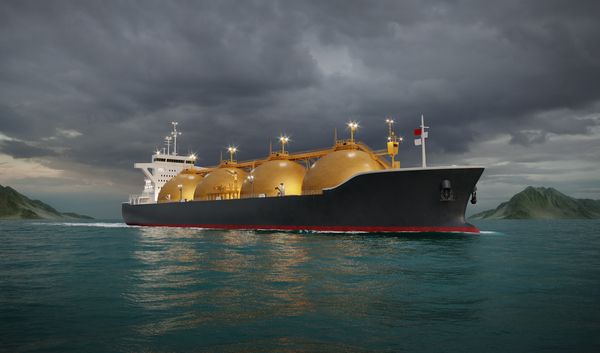Cheniere Energy (LNG 0.43%) climbed 114% over the course of 2012 . It was an outstanding performance for a company that doesn't make money, and probably won't start making money until 2015. At the earliest.
So how did this happen and, more importantly, should investors keep buying?
Back story
For investors new to the company, the Cheniere story is pretty interesting. It started as an exploration and production company, then decided the real money was in importing LNG, and then decided that the money was not in importing, but exporting LNG. For real this time.
Luckily for Cheniere, the prime location for an import facility is also a prime location for an export facility, and the company has that in spades via ownership in its master limited partnership, Cheniere Energy Partners (CQP 1.60%). Like many MLPs, Cheniere Energy Partners owns all of the assets, while parent Cheniere takes a cut and makes managerial decisions that guide the business. Its assets are on the Gulf Coast, and construction is moving right along, with a 2015 target date for first export in sight.
So what made the stock pop? Essentially, Cheniere is the only U.S. company right now with permission to export LNG to virtually anyone it pleases. It was the first company attempting to export LNG to get all its ducks in a row, including regulatory approval from both the Department of Energy and FERC, financing, and customer agreements.
Room to run?
Cheniere's stock may continue to rise on news events, or macroeconomic trends that intimate that the price of gas in Asia and Europe will stay higher than the price of gas in the U.S., but this is a speculative play I'm happy to avoid. Energy markets are incredibly volatile, and the future of the world gas market is far from certain. Heck, Cheniere's own company history tells us that.
Let's explore, for a minute, what would happen if a country in one of the big LNG importing regions suddenly tapped into a vast amount of gas. I'll use China, as it is a very real possibility right now.
The Energy Information Administration estimates that China's technically recoverable shale gas resources are 50% larger than what the U.S. has . For a country that's expected to quadruple its LNG consumption over the next seven years, an ability to exploit that resource is game-changing on a global scale . China is trying to move from zero to 60, given that it produced no shale gas in 2011, and hopes to produce 230 billion cubic feet by 2015. The goal is nothing if not ambitious, given the industry expertise and manpower that China currently lacks.
Critics of China's shale future are quick to point out that the country doesn't have the pipeline system we do, nor does it have the water resources to scale up technologies, like hydraulic fracturing, that are necessary in shale gas production. But, where there's a will, there's a way, and China's shale gas reserves proved willful enough to send ConocoPhillips (COP +1.45%) overseas to join forces with Sinopec (SHI +0.00%) to figure out how to get that gas out of the ground.
China for sale
In an effort to kick-start production, China put 20 shale blocks up for auction in September and October of last year. Eighty-three companies made 152 bids for the blocks, so the game is officially afoot . That being said, even Chinese energy analysts doubt there will be much to note in this sector before 2015 .
But remember, the first well was drilled in the U.S.' Marcellus Shale in 2004 , and it only took four years for the price of natural gas to begin collapsing, finally bottoming out (hopefully) around the halfway point of last year. Though part of that drop can be blamed on the recession, most of it is because of a huge increase in production.
If -- and that is definitely an "if" -- this precedent were to hold true in China, it could change the U.S. LNG export story dramatically. A price collapse in Asia would decimate Cheniere's ability to make money. The long-term contracts the company has in place lock-in sales volumes, not prices. Margins are what make LNG export attractive, and Cheniere's future is more or less dependent on arbitrage. In order for it to be worthwhile for Cheniere to export LNG, the company needs to beat what it estimates are break-even delivery costs of $7.70 and $9.45 per mmbtu in Europe and Asia, respectively .
That model is built on several assumptions, however, including the price of the U.S.-produced gas that Cheniere must purchase, and shipping costs, not to mention the price gas is selling for in target markets. The import price of natural gas in Europe has ranged from a low of $9.36 to a high of $11.97 per mmbtu over the past two years, while Japan has seen prices hit a low of $11.45 and a high of $18.11 per mmbtu over the same period. The price of gas in the U.S. has ranged from $2.00 to around $3.50 in 2012.
The opportunity is obvious, but markets are unpredictable beasts; if the global price of natural gas drops too low, or the domestic price of natural gas climbs too high, Cheniere's margins will suffer.
Foolish takeaway
If Cheniere were to export gas tomorrow, I would be much more likely to consider it as an investment. But waiting two more years to see if this thing will sink or swim is more risk than this Fool is willing to take on right now. In the meantime, there are plenty of other energy investments to investigate -- including companies with more developed business models that can hedge their LNG ventures with other revenue streams, like Chevron (CVX +1.35%) and Apache(APA +1.72%).










